Page 11 of 350
THINGS TO KNOW BEFORE STARTING YOUR VEHICLE
CONTENTS
�IMPORTANT VEHICLE INFORMATION .......12
▫ High Voltage Battery ....................12
� 500e ELECTRIC VEHICLE FEATURES .........14
▫ Audible Pedestrian Warning System .........14
▫ Single-Speed Transmission ................15
▫ Auto Park ............................15
▫ E-Park ..............................15
▫ Climate Control (HVAC System) ............16
▫ Electric Air Conditioning Compressor ........16
▫ Electric Power Steering ..................16 ▫
Smartphone Features ....................16
� ELECTRIC SYSTEM OPERATION ............20
▫ Level 1 Charging
(120V — Requires NEMA 5–15 Outlet) .......20
▫ Level 2 Charging
(240V — Requires A 40 Amp Circuit Breaker
Or Greater) ...........................20
▫ Charge Times .........................20
▫ Vehicle Charging Cord ...................21
▫ EVSE Operation And Status Information ......22
▫ Charging The High Voltage Battery ..........25
2
Page 17 of 350
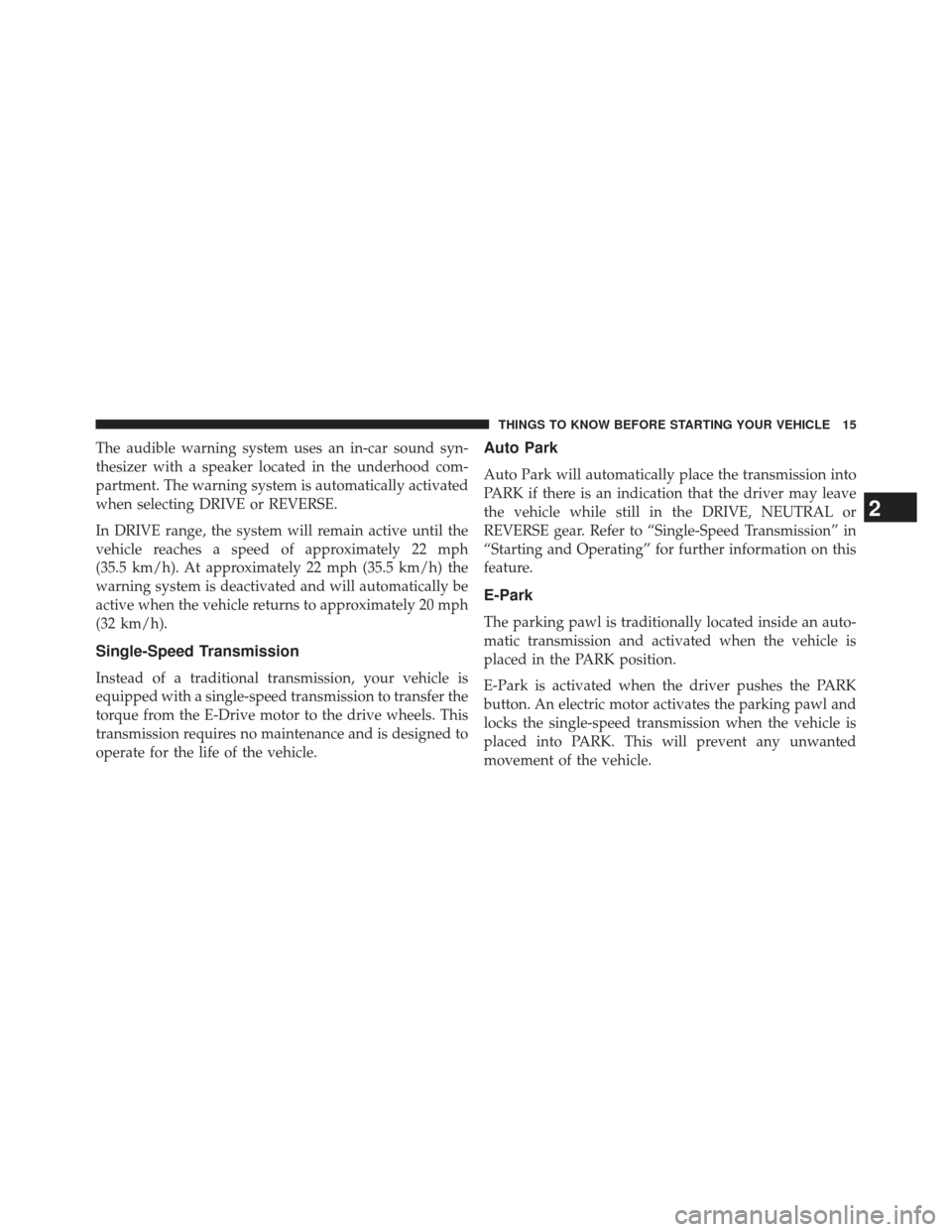
The audible warning system uses an in-car sound syn-
thesizer with a speaker located in the underhood com-
partment. The warning system is automatically activated
when selecting DRIVE or REVERSE.
In DRIVE range, the system will remain active until the
vehicle reaches a speed of approximately 22 mph
(35.5 km/h). At approximately 22 mph (35.5 km/h) the
warning system is deactivated and will automatically be
active when the vehicle returns to approximately 20 mph
(32 km/h).
Single-Speed Transmission
Instead of a traditional transmission, your vehicle is
equipped with a single-speed transmission to transfer the
torque from the E-Drive motor to the drive wheels. This
transmission requires no maintenance and is designed to
operate for the life of the vehicle.
Auto Park
Auto Park will automatically place the transmission into
PARK if there is an indication that the driver may leave
the vehicle while still in the DRIVE, NEUTRAL or
REVERSE gear. Refer to “Single-Speed Transmission” in
“Starting and Operating” for further information on this
feature.
E-Park
The parking pawl is traditionally located inside an auto-
matic transmission and activated when the vehicle is
placed in the PARK position.
E-Park is activated when the driver pushes the PARK
button. An electric motor activates the parking pawl and
locks the single-speed transmission when the vehicle is
placed into PARK. This will prevent any unwanted
movement of the vehicle.
2
THINGS TO KNOW BEFORE STARTING YOUR VEHICLE 15
Page 34 of 350
Ignition Key Removal
1. Place the transmission in PARK.
2. Rotate the key to the OFF/LOCK position.
3. Remove the key from the ignition switch lock cylinder.
Ignition Switch Positions
1 — STOP (OFF/LOCK) 3 — AVV (START)
2 — MAR (ACC/ON/RUN)
32 THINGS TO KNOW BEFORE STARTING YOUR VEHICLE
Page 35 of 350
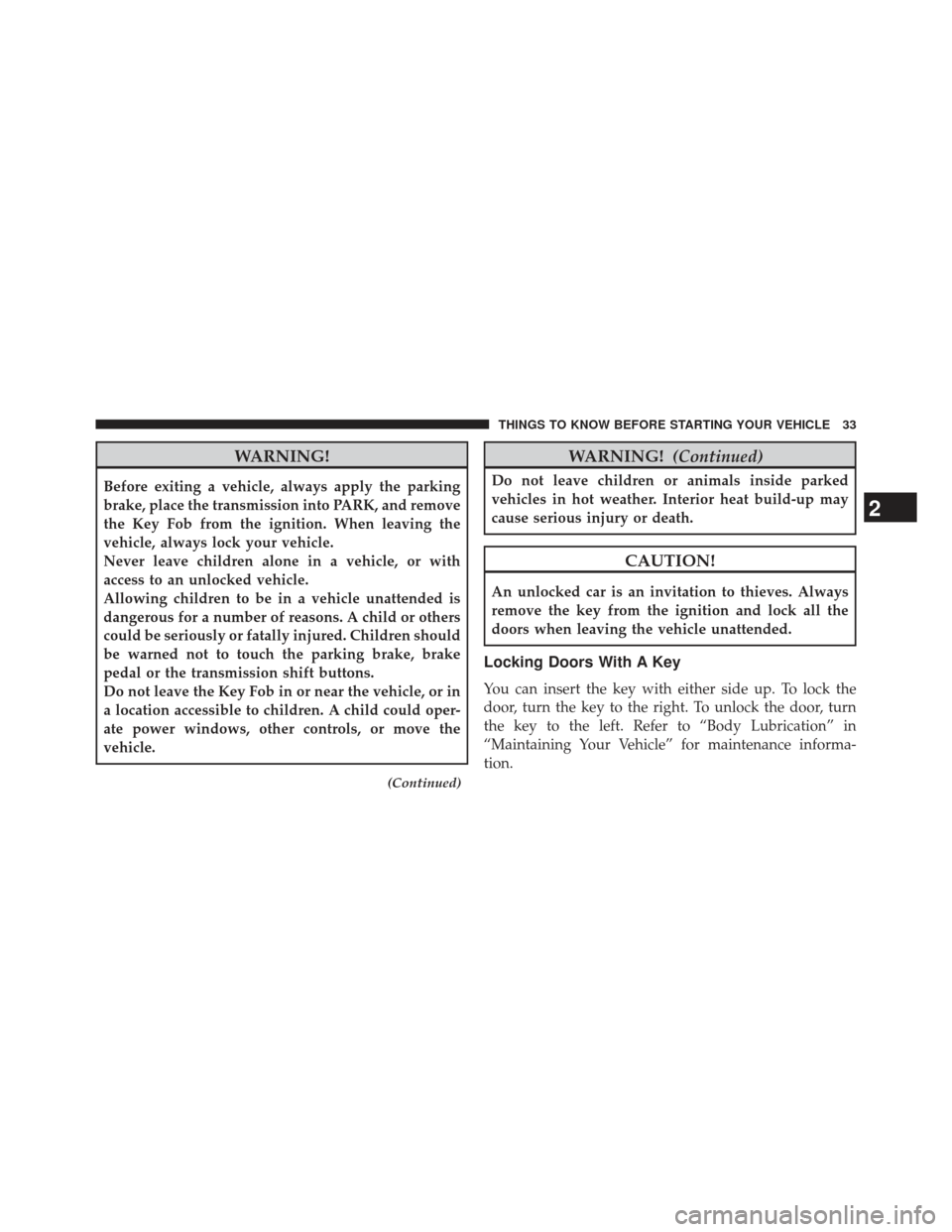
WARNING!
Before exiting a vehicle, always apply the parking
brake, place the transmission into PARK, and remove
the Key Fob from the ignition. When leaving the
vehicle, always lock your vehicle.
Never leave children alone in a vehicle, or with
access to an unlocked vehicle.
Allowing children to be in a vehicle unattended is
dangerous for a number of reasons. A child or others
could be seriously or fatally injured. Children should
be warned not to touch the parking brake, brake
pedal or the transmission shift buttons.
Do not leave the Key Fob in or near the vehicle, or in
a location accessible to children. A child could oper-
ate power windows, other controls, or move the
vehicle.
(Continued)
WARNING!(Continued)
Do not leave children or animals inside parked
vehicles in hot weather. Interior heat build-up may
cause serious injury or death.
CAUTION!
An unlocked car is an invitation to thieves. Always
remove the key from the ignition and lock all the
doors when leaving the vehicle unattended.
Locking Doors With A Key
You can insert the key with either side up. To lock the
door, turn the key to the right. To unlock the door, turn
the key to the left. Refer to “Body Lubrication” in
“Maintaining Your Vehicle” for maintenance informa-
tion.
2
THINGS TO KNOW BEFORE STARTING YOUR VEHICLE 33
Page 38 of 350
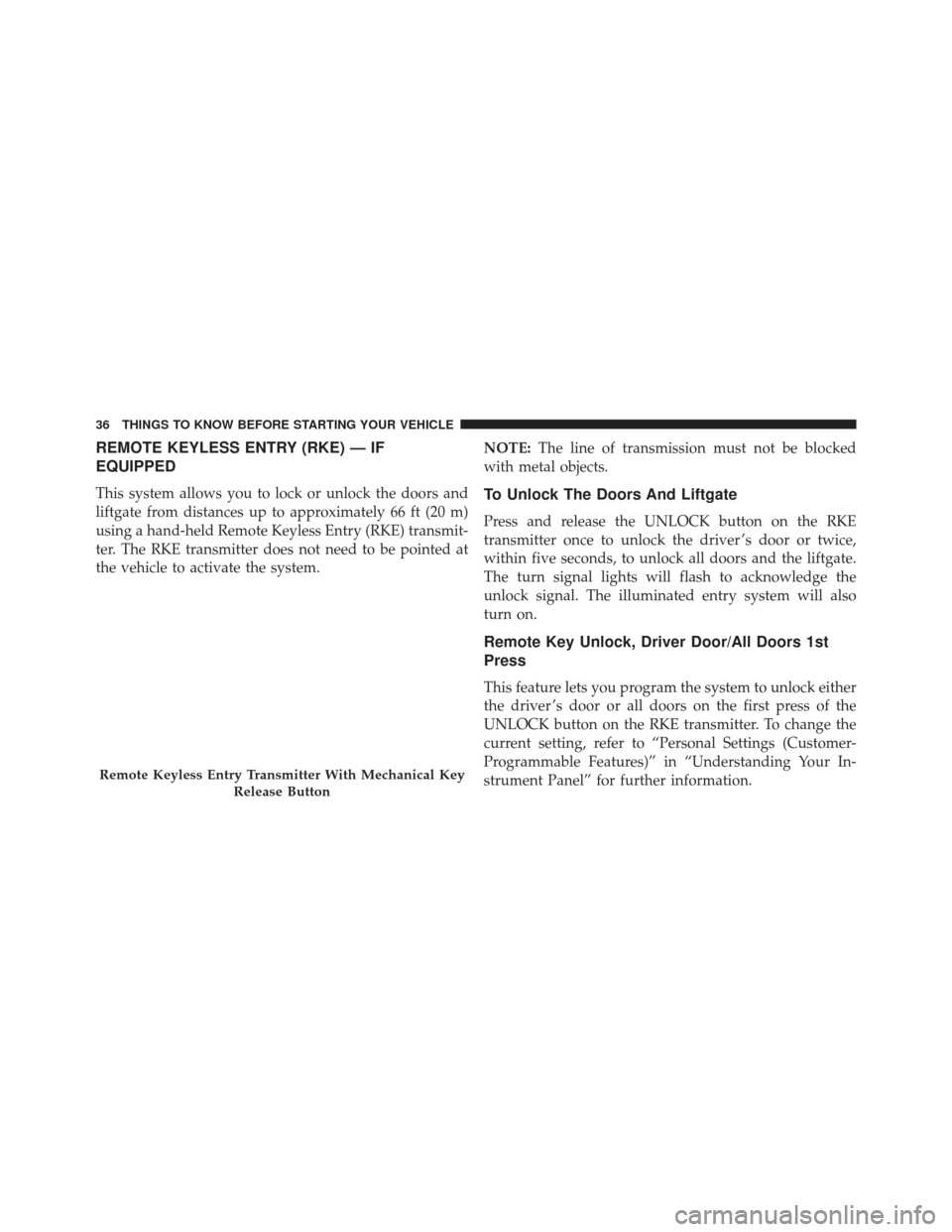
REMOTE KEYLESS ENTRY (RKE) — IF
EQUIPPED
This system allows you to lock or unlock the doors and
liftgate from distances up to approximately 66 ft (20 m)
using a hand-held Remote Keyless Entry (RKE) transmit-
ter. The RKE transmitter does not need to be pointed at
the vehicle to activate the system.NOTE:
The line of transmission must not be blocked
with metal objects.To Unlock The Doors And Liftgate
Press and release the UNLOCK button on the RKE
transmitter once to unlock the driver ’s door or twice,
within five seconds, to unlock all doors and the liftgate.
The turn signal lights will flash to acknowledge the
unlock signal. The illuminated entry system will also
turn on.
Remote Key Unlock, Driver Door/All Doors 1st
Press
This feature lets you program the system to unlock either
the driver ’s door or all doors on the first press of the
UNLOCK button on the RKE transmitter. To change the
current setting, refer to “Personal Settings (Customer-
Programmable Features)” in “Understanding Your In-
strument Panel” for further information.
Remote Keyless Entry Transmitter With Mechanical Key
Release Button
36 THINGS TO KNOW BEFORE STARTING YOUR VEHICLE
Page 42 of 350
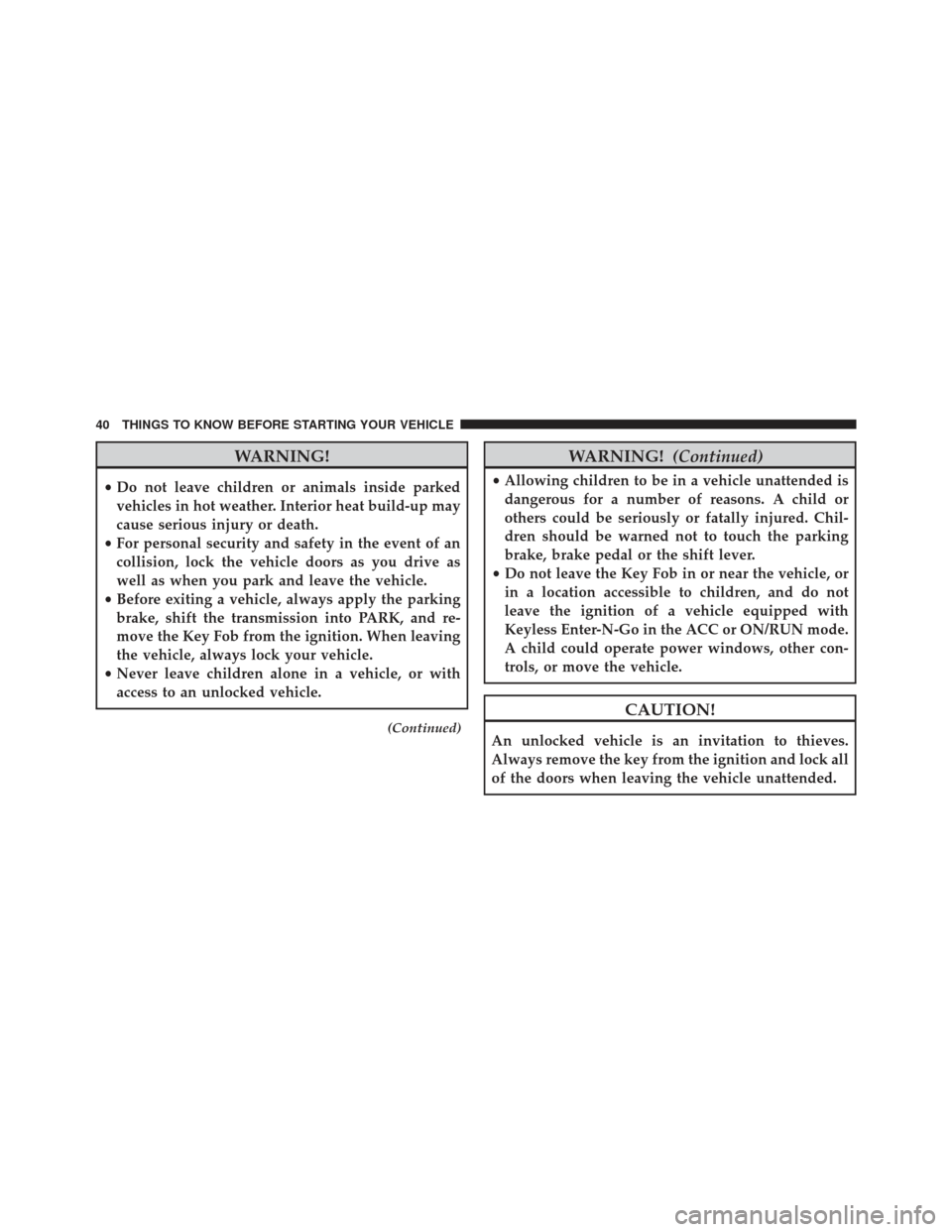
WARNING!
•Do not leave children or animals inside parked
vehicles in hot weather. Interior heat build-up may
cause serious injury or death.
• For personal security and safety in the event of an
collision, lock the vehicle doors as you drive as
well as when you park and leave the vehicle.
• Before exiting a vehicle, always apply the parking
brake, shift the transmission into PARK, and re-
move the Key Fob from the ignition. When leaving
the vehicle, always lock your vehicle.
• Never leave children alone in a vehicle, or with
access to an unlocked vehicle.
(Continued)
WARNING! (Continued)
•Allowing children to be in a vehicle unattended is
dangerous for a number of reasons. A child or
others could be seriously or fatally injured. Chil-
dren should be warned not to touch the parking
brake, brake pedal or the shift lever.
• Do not leave the Key Fob in or near the vehicle, or
in a location accessible to children, and do not
leave the ignition of a vehicle equipped with
Keyless Enter-N-Go in the ACC or ON/RUN mode.
A child could operate power windows, other con-
trols, or move the vehicle.
CAUTION!
An unlocked vehicle is an invitation to thieves.
Always remove the key from the ignition and lock all
of the doors when leaving the vehicle unattended.
40 THINGS TO KNOW BEFORE STARTING YOUR VEHICLE
Page 69 of 350

covers the window. The air bag inflates in about 30
milliseconds (about one-quarter of the time that it takes
to blink your eyes) with enough force to injure you if you
are not belted and seated properly, or if items are
positioned in the area where the side curtain air bag
inflates. This especially applies to children. The side
curtain air bag is about 3-1/2 in (9 cm) thick when it is
inflated.
Because air bag sensors estimate deceleration over time,
vehicle speed and damage are not good indicators of
whether or not an air bag should have deployed.
Front And Side Impact Sensors
In front and side impacts, impact sensors can aid the
ORC in determining appropriate response to impact
events.
Enhanced Accident Response System
In the event of an impact causing air bag deployment, if
the communication network and power remains intact,
depending on the nature of the event, the ORC will
determine whether to have the Enhanced Accident Re-
sponse System perform the following functions:
•Disable the high voltage battery.
• Place the transmission into PARK.
• Flash hazard lights as long as the 12 Volt battery has
power or until the ignition key is turned off.
• Turn on the interior lights, which remain on as long as
the 12 Volt battery has power or until the ignition key
is removed.
• Unlock the doors automatically.
2
THINGS TO KNOW BEFORE STARTING YOUR VEHICLE 67
Page 70 of 350
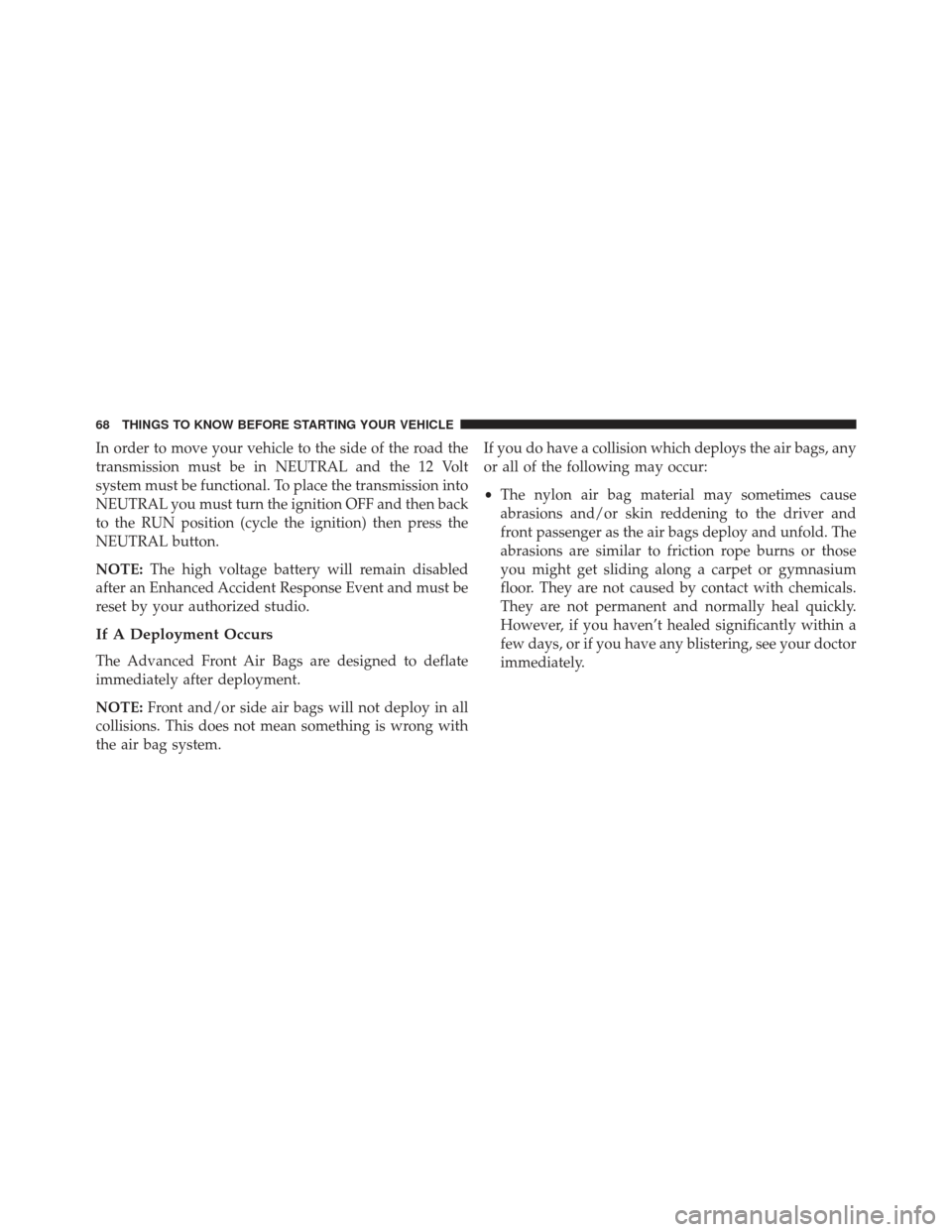
In order to move your vehicle to the side of the road the
transmission must be in NEUTRAL and the 12 Volt
system must be functional. To place the transmission into
NEUTRAL you must turn the ignition OFF and then back
to the RUN position (cycle the ignition) then press the
NEUTRAL button.
NOTE:The high voltage battery will remain disabled
after an Enhanced Accident Response Event and must be
reset by your authorized studio.
If A Deployment Occurs
The Advanced Front Air Bags are designed to deflate
immediately after deployment.
NOTE: Front and/or side air bags will not deploy in all
collisions. This does not mean something is wrong with
the air bag system. If you do have a collision which deploys the air bags, any
or all of the following may occur:
•
The nylon air bag material may sometimes cause
abrasions and/or skin reddening to the driver and
front passenger as the air bags deploy and unfold. The
abrasions are similar to friction rope burns or those
you might get sliding along a carpet or gymnasium
floor. They are not caused by contact with chemicals.
They are not permanent and normally heal quickly.
However, if you haven’t healed significantly within a
few days, or if you have any blistering, see your doctor
immediately.
68 THINGS TO KNOW BEFORE STARTING YOUR VEHICLE